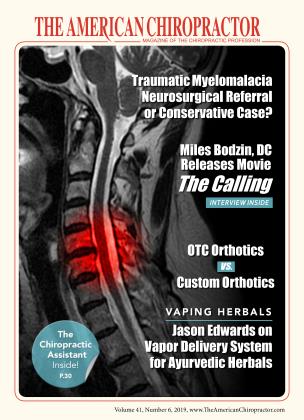The Lungs
ORGAN OF THE MONTH
Howard F. Loomis, Jr., DC
Introduction
Stress has been identified by the American Medical Association as the number one proxy killer disease today. Proxy because most often stress is the real cause of illness in more than 60% of all human illness and disease. However, it largely goes unnoticed as the underlying cause.
Stress is insidious, dangerous, and very expensive to treat. It plays an important role in modulating the pyschoneuroimmunological systems of the body. Thus, it is behind the initiation, exacerbation, and maintenance of most killer diseases, such as heart disease, hypertension, diabetes, cancer, mental illnesses, etc.
Stress is a specific diagnosis that precedes every pathological process. My purpose in writing these articles is how to point out the deleterious effects of stress on the body before disease can be diagnosed.
Organ of the Month
This month, we highlight the lungs and bronchi. There is an obvious connection between the structural and visceral symptoms associated with this organ and how it is affected by stress, regardless of the source. The space it occupies in the chest cavity and its relationship with the heart gives us a glimpse into what is occurring structurally. Obviously, the two organs must work together. Also, there is an important relationship with the spleen, which we will cover next month.
Structural Relationships
It is not necessary to consider specific muscles in an analysis of movement because they work together for a common purpose and often share a common nerve supply. Therefore, a correlation of function with nerve supply is of diagnostic value—we can make it as specific as we care to.
Visceral dysfunction in the lungs and bronchi can cause involuntary muscle contractions in the pectoralis major and minor, infraspinatus and supraspinatus, as well as the teres major and minor and to the intercostal muscles, both internal and external, just to mention the most obvious. Contractions in the erector spinae can extend from C3 to T8 or 9.
An underlying lung and bronchi dysfunction can be responsible for causing and perpetuating altered range of motion in the neck, shoulder, upper extremities, and upper and middle thoracic spine.
Embryological Connections
The lungs as breathing organs are unnecessary for intrauterine existence. Nevertheless, they must be developed to such an extent that they are immediately ready to function following birth. This explains why the entire development extends from the embryonic period through the fetal period up until birth (and even afterward).
During intrauterine life, the lungs are nevertheless an important source of amniotic fluid. Daily, 15 ml per kg of body weight is produced that flows out via the trachea and mouth or is swallowed.
The first sign of lung development occurs during the fourth week of embryonic development as an outgrowth of the foregut endoderm. As this develops, longitudinal mesodermal folds form that eventually pinch off to separate the trachea from the esophagus.
At the end of the embryonic period, the first segments appear in the five lobes of the lungs. With their distended ends, the lungs resemble an exocrine gland and the pulmonary vessels have formed.
By the end of the fourth week, the trachea divides into two primary bronchi (right and left). A few days later, the primary bronchi divide into secondary bronchi (three on the right and two on the left, corresponding to the lobes of the lungs).
Stress-Related Symptoms: Sympathetic Stimulation
The lungs are one of the major organs in the body responsible for maintaining normal acid-base balance in the blood. A relative deficiency of potassium (an alkaline mineral) and a shift of the acid-base balance toward the acid side causes greater responsiveness of these tissues to sympathetic impulses, giving rise to symptoms as seen in either bronchitis or asthma.
This causes constriction of the bronchi and increased secretion of mucus. A slowing of heart rate (bradycardia) and a possible tendency of heart block and coronary spasm may logically occur in cases of extreme exhaustion of normal homeostatic function.
Nutritional Considerations
If the stress has been long continued and the tissues become exhausted, then removal or reduction of the stress is required before improvement can be expected. Of course, nutritional excesses are often the key in these situations.
Paramount in any symptom pattern lies within the patients’ diet. Look for excessive simple sugar ingestion or digestion with associated depletion of its alkaline minerals, especially potassium and magnesium, both of which have intricate relationships with calcium. This in turn requires adequate protein to function effectively. Inquire into digestive symptoms and bowel elimination patterns. Nutritional supplementation should be directed at those areas as opposed to seeking a “magic bullet” for symptomatic relief.
Conclusion
In the months ahead, we will look at the visceral and structural connections between the spleen and lungs.
Dr. Loomis has an extensive background in enzymes and enzyme supplements. He is the founder and president of the Food Enzyme Institute™. His extensive knowledge of physiology, biochemistry, and enzymology has made him a sought-after speaker and a prolific writer, with titles such as: ENZYMES: The Key to Health in 1999, as well as The Enzyme Advantage: For Healthcare Providers and People Who Care About Their Health, also with medical Journalist Arnold Mann, in 2015. Contact info: customerservice@ foodenzymeinstitute.com, 800662-2630.
 View Full Issue
View Full Issue









